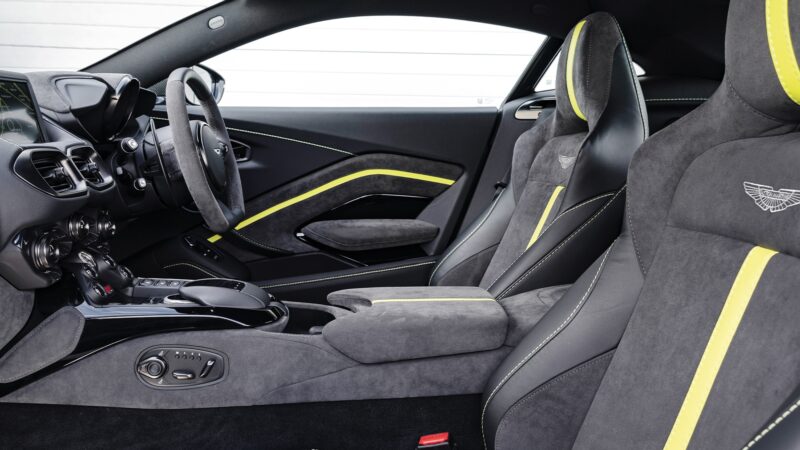2021 Aston Martin Vantage F1 Edition review
Celebrating Aston’s return to Formula 1, the Vantage F1 Edition overcomes the shortfalls of the 2018 original, says Andrew Frankel

British Racing Green, naturally. Other hues include Jet Black and Lunar White, all in satin, pictured, or gloss
It is no secret that the Aston Martin Vantage did not exactly leap out of the starting blocks when it went on sale three years ago. In fact the relative lack of success of this most important model – not just for the volumes in which it should have sold, but the more youthful buyer to whom it should have appealed – was one of quite a few reasons the company was in such dire straits that last year it found itself in need of a new senior management team.
And this, the Vantage F1 Edition, is the first visible fruit of that new arrangement, though it should be said that the turnover of senior staff has scarcely abated since Tobias Moers, the former boss of AMG, took over. Indeed since his arrival David King – one of Aston’s longest serving and most highly respected engineers – gifted stylist Miles Nurnberger and chassis development wizard Matt Becker have all left the building.
For now this ‘F1’ Vantage has to address the problems that were perceived to have held back the original which, incidentally, remains on sale. Principally these were that it didn’t look good enough and didn’t perform well enough for the price asked.

And what is most interesting about this new model is not how radical are the changes required to transform the car for the better, but how modest. For instance when Moers was at AMG and supplying Aston Martin with engines, he provided base-spec power units to which very little could be done. But now, as he has proudly pointed out to me, the “whole AMG toybox” is his to plunder at will. Yet the F1 Edition Vantage has had a power increase of just 25bhp, to 528bhp. There are versions of this engine in Stuttgart machines that top 640bhp.
There could also have been dramatic changes to the chassis, doubling the spring rates as Porsche did with the current 911 GT3. But no, it’s all very subtle: some structural strengthening at the front to improve steering response, there’s a slightly stiffer spring at the back, reprogrammed damping and rise in standard wheel diameter to 21in. They’ve not even gone for that easiest of easy wins and given it more track-orientated tyres: it could easily have fitted a Pirelli Corsa boot and made a Trofeo R optional and achieved its target of a 15-second improvement in Nürburgring lap time with no further modifications at all, but no. A standard P Zero has been retained.
“Aston has dispensed with the manual as an extravagance”
And don’t point to that rear wing and front winglets as evidence of just how changed it is: they add 200kg of downforce at 195mph, which equates to an almost meaningless amount at any speed at which you’re likely to be taking a corner. Their real purpose is simply to flag how different this car is. And, contrary to what you might expect given such limited upgrades, different it truly is.
During my time with the Vantage F1 Edition I drove it up through the middle of Wales while the world slept, spent another day driving it around the Anglesey Circuit whereafter and utterly exhausted as I was, I took the easy way out and loped around the motorway system back to base. A reasonably thorough examination, then.
Not once in all that time did I spot the flaw in those modifications. The car was no less quiet or comfortable than I remembered. And because it still sits on sensible tyres, you didn’t have to back off disproportionately when it rained. I wasn’t fussed about the power increase which equates to a rise of less than 5%, but the way it now handles is a new level for Aston Martin.
In the past it was what I’d call an eight-tenths car, which meant it was fine while you weren’t absolutely wringing its neck. Even when you did it was amiable enough, but you only need to drive this new version to realise just how much sharpness and precision was missing from the standard car. I thought the composure and accuracy I had enjoyed so much in Snowdonia might desert it at race pace, but actually, and if anything, the car felt even better as it accommodated all driving styles from fast and smooth to tyre-rinsing idiot with equal ability.

Grey Alcantara and lime-green piping, but for the price more should be expected
There remains stuff not to like: the interior is simply not worthy of the price tag, and I’d happily do without those wings – they don’t do much and add a boy-racer dimension for which I don’t much care. And I notice that Aston Martin has quietly dispensed with the manual gearbox option as a needless extravagance… but I liked the manual.
Even so, and as a first indication of the direction in which Moers wants to take Aston Martin, it’s an impressive statement of intent. But it does also make you wonder if a car can be so improved by such a small move, how much better even than that could it be with a big fat one, like shovelling Aston’s V12 engine under its bonnet which we know is possible because in essential mechanical terms, that’s what the limited-edition Aston Martin Speedster is. That’s an intriguing possibility and one that is likely to come true some time next year. And I look forward to making its acquaintance.
Aston Martin Vantage F1 Edition statistics
Price £142,000
Engine 4 litres, eight cylinders, turbocharged, petrol
Power 528bhp at 6000 rpm
Torque 505lb ft at 2000rpm
Weight 1570kg
Power to weight 336bhp per tonne
Transmission Eight-speed automatic, rear-wheel drive
0-62mph 3.6sec
Top speed 195mph
Economy 24.3mpg
CO2 264g/km
Verdict Subtle differences, big return

